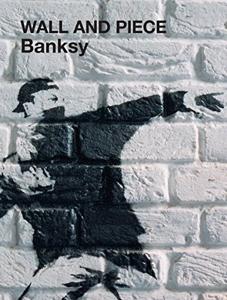
Want to learn the ideas in Wall and Piece better than ever? Read the world’s #1 book summary of Wall and Piece by Banksy here.
Read a brief 1-Page Summary or watch video summaries curated by our expert team. Note: this book guide is not affiliated with or endorsed by the publisher or author, and we always encourage you to purchase and read the full book.
Video Summaries of Wall and Piece
We’ve scoured the Internet for the very best videos on Wall and Piece, from high-quality videos summaries to interviews or commentary by Banksy.
1-Page Summary of Wall and Piece
Overall Summary
Wall and Piece is a book that tells the story of Banksy, an anonymous street artist who has painted walls in cities around the world. The book is divided into six parts: Monkeys, Cops, Rats, Cows, Art, and Street Furniture. It uses both autobiographical bits of information as well as his stenciled art projects to tell his story. He creates new ways to narrate by painting on walls or using other artistic mediums like sculptures or installations.
Banksy is an anonymous street artist from Bristol, England. He begins by saying that graffiti isn’t the lowest form of art, but rather it’s the most honest one. It can be found on almost any wall in a city and everyone is welcome to see it without paying for admission. Banksy then says he had a revelation when he was 18 years old: He painted “LATE AGAIN” on a wall and watched as police officers came after him with guns drawn. While his friends escaped in their car, Banksy hid under an oil-leaking truck for hours until the police left. Hiding there, he realized that if people wanted to know who painted something they would have to do more than just copy other artists’ work; they’d have to find out who actually did paint it. So Banksy began using stencils of monkeys instead of writing his name or anything else that could give away his identity.
The second part of the book features a satirical take on police officers and law enforcement. Banksy’s art shows that cops are hypocritical, often acting in direct opposition to what they stand for. In 1989, during a Romanian revolution, Banksy was inspired by the way people were able to subvert their oppression through graffiti art spaces. He often draws parallels between war zones and graffiti artist areas because he believes that both places have similar social dynamics where authority is questioned and power is challenged.
The third part of the book features a rat motif. Banksy connects rats to graffiti artists, saying that both exist without permission and are persecuted for their art. They live in quiet desperation among filth, but are capable of bringing down civilizations with their art. If you’re dirty and insignificant, then rats are your role model because they can do it too. This section is full of stenciled images of rats holding protest signs like “welcome to hell” and “keep music evil.” The author admits he painted these works until someone pointed out that they were anagrams for arts (artists). He concludes by saying we need more streakers—people who run through public places naked—to shake things up in this world where people have become complacent about everything around them.
The fourth section of the book highlights Banksy’s stencil work on “Cows”. He once snuck into a zoo and started printing the phrase, “laugh now but I will be in charge.” In an effort to fight back against his critics who said he couldn’t sell his art on the street (a definition of graffiti), Banksy decided to parody Monet’s “Water Lilies” by maniacally placing various cow images throughout Spain. Each image was part of a larger series called “Hick Hop: The Rural Assault.
The fifth section of the book details Banksy’s work on art. He vandalizes oil paintings and preexisting art pieces with subversive, satirical images. Many of these images include police tape, infants acting dangerously, and human pollution in natural landscapes. Banksy takes particular delight in posting a stenciled image of a can of tomato soup in New York’s Modern Museum of Art after watching throngs of people inspect the painting for five minutes.
The final part of the book shows Banksy’s work with street furniture. He argues that graffiti can make boring public sculptures more noticeable by adding phrases and artwork to them. Whether it is signs, cones, security cameras or barriers, Banksy adds his art to these objects. His advice for making stencils is “artwork that is only about wanting fame will never make you famous.”






